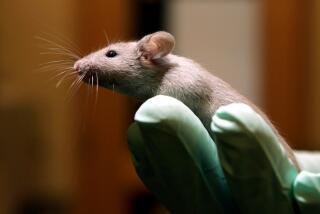A Man or a Mouse? Or Both?
- Share via
What happens when you cross a human and a mouse? Sounds like the beginning of a bad joke but, in fact, it’s a serious experiment recently carried out by a research team headed by a distinguished molecular biologist, Irving Weissman, at Stanford University. Scientists injected human brain cells into mouse fetuses, creating a strain of mice that was approximately 1% human. Weissman is considering a follow-up experiment that would produce mice whose brains are made up of 100% human cells.
What if the mice escaped the laboratory and began to proliferate in the outside environment? What might be the ecological consequences of mice with human brain cells let loose in nature?
Weissman says that, of course, he would keep a tight rein on the mice and if they showed even the slightest signs of humanness, he would kill them. Hardly reassuring.
In a world where the bizarre has become all too commonplace, few things shock the human psyche. But experiments like the one that produced a partially humanized mouse stretch the limits of human tinkering with nature to the realm of the pathological.
This new research field -- creating hybrid creatures out of different species -- is at the cutting edge of the biotech revolution and is called chimeric experimentation (after the monster of Greek mythology that was part lion, part goat and part serpent).
The first such chimeric experiment occurred many years ago when scientists in Edinburgh, Scotland, fused together a sheep and goat embryo -- two completely unrelated animal species that are incapable of mating and producing a hybrid offspring in nature. The resulting creature, called a geep, was born with the head of a goat and the body of a sheep.
Now, scientists have their sights trained on breaking the final taboo in the natural world -- crossing humans and animals to create new human-animal hybrids of every kind and description. Already, aside from the humanized mouse, scientists have created pigs with human blood running through their veins and sheep with livers and hearts that are mostly human.
The experiments are designed to advance medical research. Indeed, a growing number of genetic engineers argue that human-animal hybrids will usher in a golden era of medicine. Researchers say the more humanized they can make research animals, the better able they will be to model the progression of human diseases, test new drugs and harvest tissues and organs for transplantation into human bodies.
Some researchers are speculating about human-chimpanzee chimeras -- creating a humanzee. A humanzee would be the ideal laboratory research animal because chimpanzees are so closely related to human beings. Chimpanzees share 98% of the human genome, and a fully mature chimp has the equivalent mental abilities and consciousness of a 4-year-old human.
Fusing a human and chimpanzee embryo -- a feat researchers say is quite feasible -- could produce a creature so human that questions regarding its moral and legal status would throw 4,000 years of ethics into utter chaos.
Would such a creature enjoy human rights and protections under the law? For example, it’s possible that such a creature could cross the species barrier and mate with a human. Would society allow inter-species conjugation? Would a humanzee have to pass some kind of “humanness” test to win its freedom? Would it be forced into doing menial labor or be used to perform dangerous activities? If the whole purpose of creating this hybrid is to perform medical experiments, could those experiments possibly be morally permissible?
Please understand that none of this is science fiction. Anticipating a flurry of new experiments, the National Academy of Sciences, the country’s most august scientific body, is expected to issue guidelines for chimeric research in April. What would be the ramifications of creating hundreds, even thousands, of new life-forms that are part human and part other creature? Creatures that could mate, reproduce and repopulate the Earth?
Bioethicists are already clearing the moral path for human-animal chimeric experiments, arguing that once society gets past the revulsion factor, the prospect of new, partially human creatures has much to offer the human race.
Of course, this is exactly the kind of reasoning that has been put forth time and again to justify what is fast becoming a macabre journey into a Brave New World in which all of nature can be ruthlessly manipulated and re-engineered to suit the momentary needs and whims and caprices of just one species, the Homo sapiens.
This time, we risk undermining our own species’ biological integrity in the name of human progress. With chimeric technology, scientists now have the power to rewrite the evolutionary saga -- to sprinkle parts of Homo sapiens into the rest of the animal kingdom as well as fuse parts of other species into our own genome and even to create new human subspecies and super-species. Are we on the cusp of a biological renaissance, as some believe, or sowing the seeds of our own destruction?
What scientists fail to mention is that there are other equally promising and less invasive alternatives to these bizarre experiments. There’s sophisticated computer modeling to study disease and to test the effectiveness and toxicity of drugs. There’s in vitro tissue culture, nanotechnology and artificial prostheses to substitute for human tissue and organs. When it comes to chimeric experimentation, then, the question is, at what price?
I believe the price is too steep. We should draw the line at this type of experimentation and prohibit any further research into creating human-animal chimeras.






